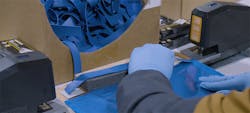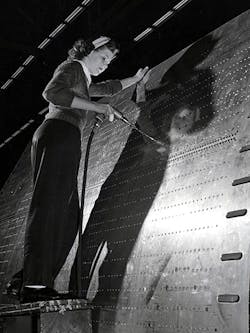Behind the scenes of Ford’s fight against COVID-19
As of April 22, Ford Motor Company has shipped more than 5 million face shields from its subsidiary Troy Design and Manufacturing (TDM) in Plymouth Township, Mich. The first face shield was made a month earlier on March 23.
The automaker ceased production of cars and trucks in North America on March 20, and right away the Ford subsidiary, which normally makes metal stamped parts for prototype vehicles, transitioned its manufacturing mission to address the shortage of personal protective equipment on the front line of the war against the novel coronavirus that causes COVID-19. Wearing a face shield in conjunction with a N95 mask provides superior protection for healthcare workers who come in close proximity to infected patients.
“Once we got the materials flowing, we steadily ramped up to where were at today,” said TDM President Todd Jaranowski. He noted the Ford Production System (FPS) for lean and efficient manufacturing, was in full effect.
“The FPS helped us organize the factory floor to better improve our effective output, as well as rate and flow, to accelerate to meet demand,” Jaranowski explained. “We went through a number of different manufacturing set ups until we found out the optimal set up that would give us the best results. This allowed us to keep safety top of mind, make stations ergonomically comfortable for our operators and decide proper cycle times.”
The workers methodically staple the top left and right corners of the translucent face shields to a foam backing and elastic headband and move on to the next one. The plant had available space and no retooling was required.
The 700 volunteer assembly workers, half from the United Auto Workers and the other half salaried employees from TDM and other sites. They work 10-hour shifts, six days a week, with some volunteers asked to work 12-hour shifts and come in on Sundays. They are paid overtime.
Stations are 6 to 7 feet apart to ensure social distancing and all employees wear face shields and gloves to prevent contamination. Non-contact temperature readings are also employed for every person who enters the building.
“We were very happy that we were able to deliver to that demand,” said Jaranowski, who has 33 years at Ford. “We have all these people at Ford Motor Company that step up and always have a can-do attitude in delivering what sometimes sounds impossible.”
Jaranowski attributed the success to the volunteers and “their excellent morale.” To keep spirits high, a cowbell was rung each time a box was filled, with workers employing a bit of friendly competition based off speed and quality.
Maybe more inspiring is the “Wall of Heroes,” an area displaying all the first responders wearing the face shields and showing how crucial the monotonous stapling of plastic to foam can be.
“When you walk around and talk to people, you find that most people have a family member or friend who is in the medical field,” Jaranowski said. “They get a big morale boost knowing that we are helping keep our family and friends safe.”
Ford has a history of scaling up when its homeland needs it. Eighty years ago, Ford’s network of factories joined the fight against the Axis Powers in World War II, replenishing the U.S.’s military assets that declined following World War I and the Great Depression. Tens of thousands of tanks, jeeps and most famously, B-24 bombers, were manufactured by the company, with efforts overseen by founder Henry Ford. Another famous icon, Rosie the Riveter, worked at the Willow Run bomber plant in Ypsilanti, Mich.
Leaving no American’s skills overlooked, Henry Ford had hired eight little people to climb inside the wing to hold backing plates during a fastening process.
“And if you read the stories…they were very proud of what they were doing,” historian Randy Hotton told the USO. “For the first time in their lives, they weren’t … sideshows. They had a real job.”
Having any sort of job is valuable during the current economic shutdown, as 26 million Americans have field for unemployment since a majority of state governments have closed non-essential businesses last month. Providing health care workers with PPE has been critical to keeping them protected so they can continue to care for patients and keep the nation’s medical system functioning.
Ford has also started making powered air-purifying respirators using 3M designs at its Vreeland facility near Flat Rock, Mich., and face masks at the Van Dyke Transmission Plant in a ISO Class 8 cleanroom.
Furthermore, airbag material is being repurposed to fabricate reusable gowns and other manufacturing resources are being diverted to assist Thermo Fisher Scientific create COVID-19 collection kits for patient testing.
This week, assembly began on Model A-E ventilators at the Rawsonville Components Plant. The goal of the collaborative effort with GE Healthcare is to create a total of 50,000 ventilators by July 4.
“We knew that to play our part helping combat coronavirus, we had to go like hell and join forces with experts like 3M to expand production of urgently needed medical equipment and supplies," said Jim Baumbick, vice president, Ford Enterprise Product Line Management. “In just three weeks under Project Apollo, we’ve unleashed our world-class manufacturing, purchasing and design talent to get scrappy and start making personal protection equipment and help increase the availability and production of ventilators.”
About the Author
John Hitch
Editor
John Hitch is the editor-in-chief of Fleet Maintenance, providing maintenance management and technicians with the the latest information on the tools and strategies to keep their fleets' commercial vehicles moving. He is based out of Cleveland, Ohio, and was previously senior editor for FleetOwner. He previously wrote about manufacturing and advanced technology for IndustryWeek and New Equipment Digest.




